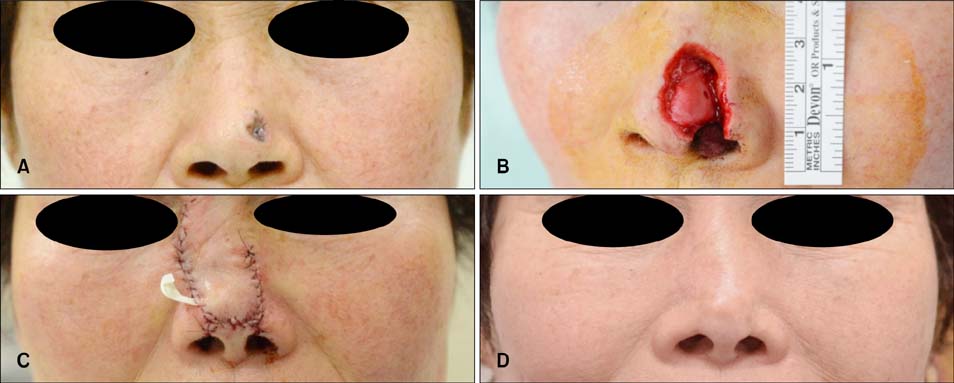Ann Dermatol.
2015 Dec;27(6):748-750. 10.5021/ad.2015.27.6.748.
A Novel Approach for Full-Thickness Defect of the Nasal Alar Rim: Primary Closure of the Defect and Reduction of the Contralateral Normal Ala for Symmetry
- Affiliations
-
- 1Department of Dermatology, Seoul National University College of Medicine, Seoul, Korea. sj.jo@snu.ac.kr
- KMID: 2157453
- DOI: http://doi.org/10.5021/ad.2015.27.6.748
Abstract
- In full-thickness defects of the nasal alar rim, to achieve projection and maintain airway patency, cartilage graft is frequently needed. However, cartilage graft presents a challenge in considerations such as appropriate donor site, skeletal shape and size, and healing of the donor area. To avoid these demerits, we tried primary closure of alar rim defects by also making the contralateral normal ala smaller. We treated two patients who had a full-thickness nasal alar defect after tumor excision. Cartilage graft was considered for the reconstruction. However, their alar rims were overly curved and their nostril openings were large. To utilize their nasal shape, we did primary closure of the defect rather than cartilage graft, and then downsized the contralateral nasal ala by means of wedge resection to make the alae symmetric. Both patients were satisfied with their aesthetic results, which showed a smaller nostril and nearly straight alar rims. Moreover, functionally, there was no discomfort during breathing in both patients. We propose our idea as one of the reconstruction options for nasal alar defects. It is a simple and easy-to-perform procedure, in addition to enhancing the nasal contour. This method would be useful for patients with a large nostril and an overly curved alar rim.
MeSH Terms
Figure
Reference
-
1. Rohrich RJ, Griffin JR, Ansari M, Beran SJ, Potter JK. Nasal reconstruction--beyond aesthetic subunits: a 15-year review of 1334 cases. Plast Reconstr Surg. 2004; 114:1405–1416.
Article2. Han DH, Mangoba DC, Lee DY, Jin HR. Reconstruction of nasal alar defects in asian patients. Arch Facial Plast Surg. 2012; 14:312–317.
Article3. Mureau MA, Moolenburgh SE, Levendag PC, Hofer SO. Aesthetic and functional outcome following nasal reconstruction. Plast Reconstr Surg. 2007; 120:1217–1227.
Article4. Kim G, Jeong YI, Shim HC, Choi JH, Jue MS, Kim EJ, et al. Auricular composite chondrocutaneous grafts in the repair of nasal alar rim defects. Ann Dermatol. 2014; 26:407–408.
Article5. Warner JP, Chauhan N, Adamson PA. Alar soft-tissue techniques in rhinoplasty: algorithmic approach, quantifiable guidelines, and scar outcomes from a single surgeon experience. Arch Facial Plast Surg. 2010; 12:149–158.6. Yotsuyanagi T, Yamashita K, Urushidate S, Yokoi K, Sawada Y. Nasal reconstruction based on aesthetic subunits in Orientals. Plast Reconstr Surg. 2000; 106:36–44.
Article
- Full Text Links
- Actions
-
Cited
- CITED
-
- Close
- Share
- Similar articles
-
- Reconstruction of Postburn Nasal Alar Defect by Paramedian Forehead Flap
- The Reverse Nasolabial Flap with a Cartilage Graft for the Repair of a Full-Thickness Alar Defect: A Single-Stage Procedure
- Hinged Turnover Flap for Reconstruction of Nasal Ala Defect
- The Full-thickness Forehead Skin Graft for a Nasal Ala Defect
- Reconstruction of Full Thickness Ala Defect with Nasolabial Fold and Septal Mucosal Hinge Flap



